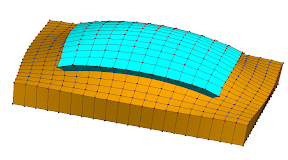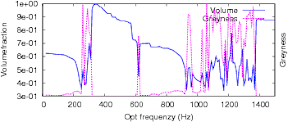There is more good news :)
It appears that we made an invention (when this is defined by something which
get's patented). Currently we construct an experimental prototype (which is real
hardware). It takes a lot of time but it is also exiting and makes a lot of fun. The details evolve along construction in discussion with the (excellent) mechanic of my
engineering chair. Next week we will start meassurements - and if all works fine
we'll try to apply for a patent.
I learned some mechanical basics before I started my first study (engineering) and
it remindes me to that times.
What is really cool, if the stuff works - it's found by optimization. Engineers are
working for quite some time to solve the problem - maybe the algorithm found it (it's not that intuitive in the first glance) ... well, let's see.
In this (private) blog I write about my research in topology optimization. Piezoelectric topology optimization was the topic of my Ph.D. thesis but I work also other fields of topology optimization. I work for Prof. Stingl and I am funded by the Excellence Cluster Engineering of Advanced Materials.
Friday 20 February 2009
Paper accepted
Lucky day today :)
Some time ago I got back the review of our first paper. I'm currently working on the next version, taking the comments of the reviewer into account.
What I did not post, is that we also submitted a second paper dealing with the dynamic optimization. It was submitted along the OIPE workshop. Here is the preprint. The comments of the two reviewers came today and were actually quite good (twice an "eight"). I was escpecially happy about the comment "The detailed discussion is nice." as a lot of effert went into that paper.
After working in the comments the paper will appear in a special issue (optimization and inverse problems) of the International Journal of Applied Electromagnetics and Mechanics IJAEM.
What is the paper about? It does dynamic optimization of the piezoelectric loudspeaker:

Brown is the thin metal plate (think of the "membrane" of a loudspeaker, even if the term is in this case not correct) which is excited by a thin piezoelectric layer (blue). We search for the best topology of the piezoelectric layer.
What needs to be clearified in the first paper, is that we need no volume constraint. Hence, when doing a parameter study optimizing for many frequencies from 20 to 2000 Hz

We can check what the optimal volume is and if it is really "black and white" enough. This is the special intrinsic piezoelectric feature we found and what needs to expressed in more detail for the revision of the first paper.

A typical example (800 Hz) is the following picture where blue means "no piezoelectric material" but brown means, "yes - place the pizeo here".

The paper discusses some interesting ressonance issues of piezoelectric optimization (it's special there!) and does also multiple frequency optimization. But that's much to much for a blog posting.
Some time ago I got back the review of our first paper. I'm currently working on the next version, taking the comments of the reviewer into account.
What I did not post, is that we also submitted a second paper dealing with the dynamic optimization. It was submitted along the OIPE workshop. Here is the preprint. The comments of the two reviewers came today and were actually quite good (twice an "eight"). I was escpecially happy about the comment "The detailed discussion is nice." as a lot of effert went into that paper.
After working in the comments the paper will appear in a special issue (optimization and inverse problems) of the International Journal of Applied Electromagnetics and Mechanics IJAEM.
What is the paper about? It does dynamic optimization of the piezoelectric loudspeaker:

Brown is the thin metal plate (think of the "membrane" of a loudspeaker, even if the term is in this case not correct) which is excited by a thin piezoelectric layer (blue). We search for the best topology of the piezoelectric layer.
What needs to be clearified in the first paper, is that we need no volume constraint. Hence, when doing a parameter study optimizing for many frequencies from 20 to 2000 Hz

We can check what the optimal volume is and if it is really "black and white" enough. This is the special intrinsic piezoelectric feature we found and what needs to expressed in more detail for the revision of the first paper.

A typical example (800 Hz) is the following picture where blue means "no piezoelectric material" but brown means, "yes - place the pizeo here".

The paper discusses some interesting ressonance issues of piezoelectric optimization (it's special there!) and does also multiple frequency optimization. But that's much to much for a blog posting.
Subscribe to:
Posts (Atom)